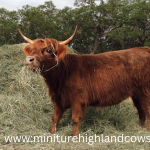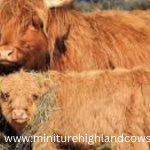Comparing Miniature Highland and Miniature Hereford Cows
For a hobby farmer or running smaller acres, miniature cows will surely serve the purpose. One of the most popular varieties include Miniature Highland and Miniature Hereford cattle. Different breeds have different characteristic attributes to suit different farming intentions. This article delves a bit more into the differences so that you can decide what breed you might need for your endeavors.

Miniature highland cow vs highland cow pros and cons
Miniature Highland Cows vs. Standard Highland Cows: Pros and Cons
Both Miniature Highland cows and standard Highland cows offer unique benefits for farmers and enthusiasts. Deciding which is better suited to your needs depends on factors such as space, budget, and intended use. Here’s a comparison of the pros and cons of each:
Miniature Highland Cows
Pros
- Smaller Size
- They are more manageable, especially for small farms or hobby homesteads.
- The animals require fewer pastures and feed as compared to the larger species.
- Low Maintenance
- Reduced feed: Their size makes them not to require much feed.
- Small housing or fencing: They will require much smaller housing or fencing in comparison to other species
- Gentle Temperament
- Miniature Highland cows possess the gentle nature of the breed, so they are good for first-timers and families. 4. Visual Value – They are loved because of their photogenic look. They are kept as pets or in agritourism activities. 5. Good Grazers – Like full-sized Highlands, they do well at grazing on rugged terrain and keeping diverse pastures.
Cons
- Less Amount of Meat
Because they are not as big, they offer less meat, making it a less practical choice when many are needed for production of beef. - Steeper Upfront Price
Often times miniature highlands have a higher purchase price since they are so rare and in demand. - **Availability Is Limited
- Harder to find than standard Highlands, which can increase acquisition challenges.
Standard Highland Cows
Pros
- Larger Meat Production
- Their size makes them more suitable for beef production, yielding more meat per animal.
- Hardiness
- Livestock that is adaptable to harsh climates and can endure rugged environments, providing protection from the elements by virtue of their thick coats. 3. Versatile Utility – Well-suited to both beef production and land management, such as brush clearing or pasture maintenance. 4. Economical on Larger Operations – More feed is required because these animals are more productive on larger operations.
Cons
- Space and Feed Requirements
- Require more pasture space and feed compared to Miniature Highlands, making them less suitable for small farms.
- Difficult to Handle
- Their larger size can make handling more difficult, particularly for novice farmers.
- **Higher Maintenance Costs
- Larger housing and fencing structures are required, which means higher costs in general.

Comparison at a Glance
| Feature | Miniature Highland | Standard Highland |
|---|---|---|
| Size | Smaller, easier to manage. | Larger, more imposing. |
| Feed Costs | Lower due to small size. | Tend to be more in comparison but proportional to yield. |
| Space Needs | Fine for small farms. | More space and facilities. |
| Meat Yield | Lower; suitable for small-scale use. | Higher; ideal for beef production. |
| Cost to Purchase | More expensive upfront. | Generally more affordable. |
| Hardiness | Adaptable but similar to standard. | Extremely hardy, great for rugged climates. |
| Purpose | Hobby farms, pets, or aesthetics. | Beef production and land |
Miniature highland cow vs highland cow size
Miniature Highland Cow vs. Standard Highland Cow: Size Comparison
Miniature Highland Cow
- Height: Typically measures 36–42 inches (91–107 cm) at the shoulder when fully grown.
- Weight: Ranges from 500–700 pounds (227–318 kg).
- Key Feature: Their compact size makes them ideal for smaller farms, easier to handle, and less demanding in terms of feed and space.
Standard Highland Cow
Height : The average shoulder height ranges between 48–52 inches or 122–132 cm, but bulls grow larger.
Weight: This breed normally weighs about 1,000–1,800 pounds or 454–816 kg depending on its sex and diet.
Keypoint: Larger Size – suited better for the beef industry and land control. Resource consuming.
Conclusion of Comparison Size
- Miniature Highlands are about 25–30% smaller in height and weight compared to the standard ones. Thus, they become a great choice for hobby farmers or those with limited space. However, standard Highlands are better suited for large-scale beef production and rugged pasture use.
Miniature Highland Cows
Origin and Appearance Miniature Highland cows are a smaller version of the traditional Highland cattle, originally bred in Scotland. They are instantly recognizable by their long, shaggy coats that come in a range of colors, including red, black, brindle, yellow, and white. Their distinct horns and expressive faces give them a charming and photogenic appearance, often showcased in picturesque rural settings.
Temperament and Adaptability
Highland cows are known for their docile and calm nature. They are not difficult to manage, even for first-time farmers. Highland cows are extremely hardy and can tolerate extreme cold climates with the help of their thick coats that act as insulators. This makes them suitable for areas with harsh winters or rugged terrains.

Grazing and Diet
Highlands are productive grazers, doing well on rough and uneven land where other breeds may be at a loss. They can be supported on a diet of largely grasses and shrubs, requiring little supplementation. Their ability to graze on a broad range of vegetation also aids in improving biodiversity in pastures.
Miniature Hereford Cows
Origin and Appearance
Miniature Hereford cow origin: This type of cows originates from the traditional Hereford breed of England. They boast an intense body color but marked white on face, white crest, underbelly and dewlap. Size: Compact Classic beef or beef-cow-like appearance Appeals farmers focused to small-sized meat production
Temperament and Adaptability
Miniature Herefords have the same nature as Highland cows, gentle and friendly, so handling them is also not that difficult. They can easily adapt to different climates, but they perform well in temperate climates. In colder places or harsh weather conditions, they would need extra care and shelter.
Grazing and Diet
Herefords prefer managed pastures with quality grasses and benefit from supplementary feeding, such as hay and grain, during leaner seasons. Their high feed-to-beef conversion efficiency makes them an excellent choice for farmers interested in producing quality beef in smaller quantities.
Key Differences Between Miniature Highland and Miniature Hereford Cows

1. Size and Appearance
- Miniature Highlands: A bit smaller, yet robust and shaggy because of their thick coats.
- Miniature Herefords: More traditional in appearance; they look like standard beef cattle but have a more compact frame.
2. Climate Suitability
- Highlands: They thrive in cold climates and on rugged terrain; their coats protect them from harsh weather naturally.
- Herefords: Perform well in temperate climates but require special attention during extreme cold or heat.
3. Purpose –
- Highlands: Frequently selected based on their appearance, friendly temperament, and adaptability as pets or for small-scale farming. They also offer a lean, palatable meat, though they are not primarily raised for beef.
- Herefords: Bred specifically for efficient beef production on a smaller scale, making them ideal for farmers focused on meat yield.
Conclusion
Both Miniature Highland and Miniature Hereford cows are excellent options for small-scale farming, but their suitability depends on your goals and environment. If you’re looking for hardy, low-maintenance cows with a unique and friendly demeanor, Miniature Highlands are a great choice. If you want beef production and a more traditional look to your farm, then Miniature Herefords would be best suited to your needs. It’s this difference that allows you to understand which breed would be suitable for your farming ambitions.
FAQs: Miniature Highland Cows vs. Standard Highland Cows
1. What is the main difference between Miniature Highland and Standard Highland cows?
Miniature Highland cows are smaller, typically standing 36–42 inches tall and weighing 500–700 pounds. Standard Highland cows are larger, standing 48–52 inches tall and weighing 1,000–1,800 pounds.
2. Are Miniature Highland cows harder to find than Standard Highland cows?
Yes, Miniature Highland cows are rarer and often more expensive because of high demand and less availability.
3. Which breed is better for small farms?
Miniature Highland cows are better suited for small farms because they require less space, feed, and maintenance compared to Standard Highlands.
*4. Do Miniature Highland cows produce less meat than Standard Highland cows?
Yes, because of their smaller size, Miniature Highlands do not produce as much meat and are therefore not as suitable for massive beef production.
5. Are both Miniature and Standard Highland cows resistant to cold weather?
Yes, both breeds have thick, shaggy coats that make them highly resistant to cold and harsh climates.
6. Can Miniature Highland cows and Standard Highland cows be kept together?
Yes, they can be kept harmoniously since both breeds are known for the same kind of temperaments and grazing behaviors.
7. Are Miniature Highland cows costlier to buy?
Miniature Highlands tend to be pricier in terms of upfront because of their relative rarity and demand.
8. Are the needs of both breeds exactly the same in terms of care?
Both need the same level of care, such as grooming of their thick coats regularly, proper shelter, and pasture space. Miniatures, however, consume less feed and require smaller accommodations.
Which is a better breed for first-timers?
Miniature Highland cows are best for first-timers due to their manageable size and handling.
10. Do Highland cows get along well with children?
Yes, both Miniature and Standard Highland cows are known for their gentle and docile temperaments, making them safe around children.
If you have additional questions, feel free to ask!










